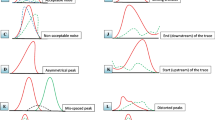Abstract
Researchers face a significant problem in PCR amplification of DNA fragments with high GC contents. Analysis of these regions is of importance since many regulatory regions of different genes and their first exons are GC-rich. There are a large number of protocols for amplification of GC-rich DNA, some of which perform well but are costly. Most of the economical protocols fail to perform consistently, especially on products with >80 % GC contents and a size of >300 bp. One of these protocols requires multiple additions of DNA polymerase during thermal cycling which therefore rules out its utility if a large number of samples have to be amplified. We have established a method for simultaneous amplification of specific PCR products from a large number of human DNA samples using general laboratory reagents. These amplicons have GC contents ranging from 65–85 % and sizes up to 870 bp. The protocol uses a PCR buffer containing co-solvents including 2-mercaptoethanol and bovine serum albumin for amplification of DNA. A specific thermal cycling profile is also used which incorporates a high annealing temperature in the first 7 cycles of the reactions. The PCR products are suitable for different molecular biology applications including sequencing.



Similar content being viewed by others
References
Mamedov, T. G., Pienaar, E., Whitney, S. E., TerMaat, J. R., Carvill, G., Goliath, R., et al. (2008). A fundamental study of the PCR amplification of GC-rich DNA templates. Computational Biology and Chemistry, 32, 452–457.
Wei, M., Deng, J., Feng, K., Yu, B., & Chen, Y. (2010). Universal method facilitating the amplification of extremely GC-rich DNA fragments from genomic DNA. Analytical Chemistry, 82, 6303–6307.
Frey, U. H., Bachmann, H. S., Peters, J., & Siffert, W. (2008). PCR-amplification of GC-rich regions: ‘Slowdown PCR’. Nature Protocols, 3, 1312–1317.
Zhang, Z., Yang, X., Meng, L., Liu, F., Shen, C., & Yang, W. (2009). Enhanced amplification of GC-rich DNA with two organic reagents. BioTechniques, 47, 775–779.
Baskaran, N., Kandpal, R. P., Bhargava, A. K., Glynn, M. W., Bale, A., & Weissman, S. M. (1996). Uniform amplification of a mixture of deoxyribonucleic acids with varying GC content. Genome Research, 6, 633–638.
Deng, J., Wei, M., Yu, B., & Chen, Y. (2010). Efficient amplification of genes involved in microbial secondary metabolism by an improved genome walking method. Applied Microbiology and Biotechnology, 87, 757–764.
Orpana, A. K., Ho, T. H., & Stenman, J. (2012). Multiple heat pulses during pcr extension enabling amplification of GC-rich sequences and reducing amplification bias. Analytical Chemistry, 84(4), 2081–2087.
Ralser, M., Querfurth, R., Warnatz, H. J., Lehrach, H., Yaspo, M. L., & Krobitsch, S. (2006). An efficient and economic enhancer mix for PCR. Biochemical and Biophysical Research Communications, 347, 747–751.
Li, L. Y., Li, Q., Yu, Y. H., Zhong, M., Yang, L., Wu, Q. H., et al. (2011). A primer design strategy for PCR amplification of GC-rich DNA sequences. Clinical Biochemistry, 44, 692–698.
Ye, S., Dhillon, S., Ke, X., Collins, A. R., & Day, I. N. (2001). An efficient procedure for genotyping single nucleotide polymorphisms. Nucleic Acids Research, 29, E88.
Grimberg, J., Nawoschik, S., Belluscio, L., McKee, R., Turck, A., & Eisenberg, A. (1989). A simple and efficient non-organic procedure for the isolation of genomic DNA from blood. Nucleic Acids Research, 17, 8390.
Miller, S. A., Dykes, D. D., & Polesky, H. F. (1988). A simple salting out procedure for extracting DNA from human nucleated cells. Nucleic Acids Research, 16, 1215.
Jeffreys, A. J., Neumann, R., & Wilson, V. (1990). Repeat unit sequence variation in minisatellites: A novel source of DNA polymorphism for studying variation and mutation by single molecule analysis. Cell, 60, 473–485.
Bashir, R., Fatima, A., & Naz, S. (2010). A frameshift mutation in SANS results in atypical Usher syndrome. Clinical Genetics, 78, 601–603.
Sarkar, G., Kapelner, S., & Sommer, S. S. (1990). Formamide can dramatically improve the specificity of PCR. Nucleic Acids Research, 18, 7465.
Winship, P. R. (1989). An improved method for directly sequencing PCR amplified material using dimethyl sulphoxide. Nucleic Acids Research, 17, 1266.
Nagai, M., Yoshida, A., & Sato, N. (1998). Additive effects of bovine serum albumin, dithiothreitol, and glycerol on PCR. Biochemistry and Molecular Biology International, 44, 157–163.
Sirmaci, A., Edwards, Y. J., Akay, H., & Tekin, M. (2012). Challenges in whole exome sequencing: an example from hereditary deafness. PLoS ONE, 7, e32000.
Acknowledgments
Some of the primers for amplification of GNAS and those of MCART1 were designed for our collaborative project with University of Lübeck, Germany and were kindly provided for this study by Dr. Christine Klein. We are grateful to Ms. Rasheeda Bashir for independently verifying this protocol with primers for TPRN. We thank Dr. Edward Wilcox for his valuable comments on the manuscript. The research was supported by Higher Education Commission, Pakistan, (Grant #836) and Fogarty International Center and National Institute on Deafness and other Communication Disorders, National Institutes of Health, USA, (R01TW007608).
Conflict of interest
The authors declare no conflict of interest.
Author information
Authors and Affiliations
Corresponding author
Additional information
Sadaf Naz and Amara Fatima contributed equally to this study.
Rights and permissions
About this article
Cite this article
Naz, S., Fatima, A. Amplification of GC-rich DNA for High-Throughput Family-Based Genetic Studies. Mol Biotechnol 53, 345–350 (2013). https://doi.org/10.1007/s12033-012-9559-y
Published:
Issue Date:
DOI: https://doi.org/10.1007/s12033-012-9559-y




